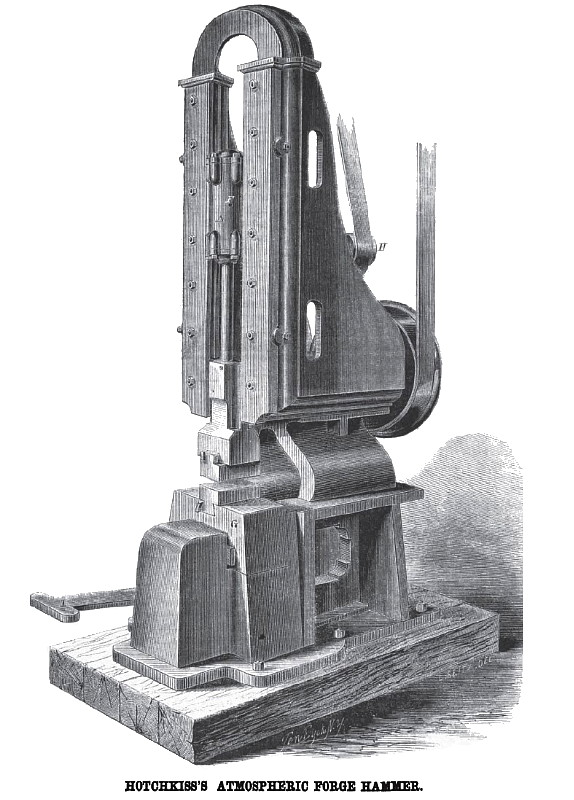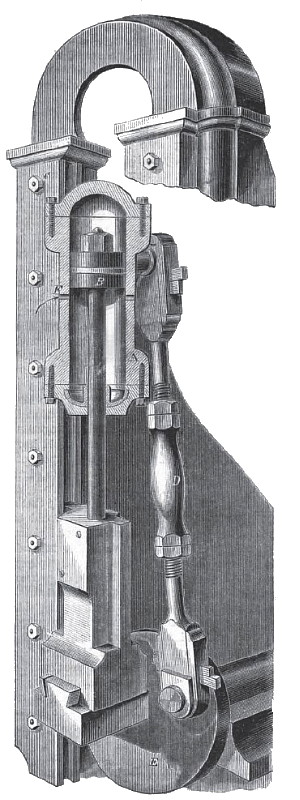|
Title: |
1864 Article-Merrill Brothers, Hotchkiss' Atmospheric Forge Hammer |
|
Source: |
Scientific American, V11, 01 Oct 1864, pg. 209 |
|
Insert Date: |
4/9/2019 7:53:48 PM |
A great improvement has been made oi late years in forging light work. Instead of relying upon the hand and eye of some skillful workman, dies have been substituted, and the jobs thus produced have all the accuracy of castings while they are far superior in strength. Many pieces in gun work, which were formerly made of malleable iron, from the supposed impossibility of forging them, are now drawn out from the solid bar at less cost than they could be cast. Drop-presses have been used on this work, as also rapid-working trip-hammers, but these make such a tremendous racket that is almost impossible to stay in their vicinity.
The hammer illustrated in this connection is, in many respects, superior to the drop or the trip-hammer, for it is under perfect control, can strike a light or a heavy blow, or any number of blows in quick succession. It can forge or draw down work of any description, and for large or small machine, or jobbing shops is an invaluable aid. On gun work, it is also indispensable and the “Starr Arms Company” are now using one in their extensive manufactory at Yonkers, N. Y. With this testimony in its favor, we pass to a brief description of its details and operation.
The hammer derives the force of its blow from compressed air. The air is compressed by a cylinder, A, and piston, B, (see Fig. 2.) The cylinder moves in the slides, C, by the action of the connecting rod, D, driven from the faceplate, E, by belting, in the usual manner. There are two small holes, F, in the cylinder, A. Through these the air enters. The whole machinery is carried in a strong iron frame. Now if we suppose the cylinder to ascend, the air will enter through the holes, F, and be compressed as the cylinder goes up. This compression is at the bottom of the cylinder and therefore lifts the hammer moving in the slides. By the time the hammer is lifted the connecting rod arrives at the top center and commences to descend. The air then enters above the piston, and as the cylinder still comes down condenses the volume very highly. This condensed air is the force stored up to make the blow, for so soon as the connecting rod turns the bottom center the confined air expands instantly and thus throws the piston and hammer down with great force. This action is repeated at every revolution, and the height of the cylinder is altered so as to forge large or small work by lengthening or shortening the connecting rod. The hammer is lifted at the ascending stroke by the compressed air below, as we stated previously, and this also aids the cylinder in compressing the air for the return blow, and it is owing to the rapid action of the two movements that the piston does not fall before it obtains the advantage of the air compressed above it.
It will be seen that this hammer is exceedingly simple in its construction; there are no valves about it to get out of order, and the packing is exceedingly durable and easy working. Both that in the piston and in the cylinder-head is made of the cup-leathers used in packing hydraulic rams, and they have run for months without leakage or perceptible wear. The dies are fastened in with keys, and the anvil block, G, is adjusted by another key, so that the dies can be set properly without delay. The speed of the hammer is regulated by an idler pulley, H, which can be operated by the treadle, I.
This ingenious and novel hammer is the subject of three patents, hearing date respectively June 14, 1859, July, 1863, and May 3, 1864, which were issued to Bennett Hotchkiss, of New Haven, Conn. For further information address the sole manufacturers, Charles Merrill & Sons, 556 Grand street, New York.
US Patents: 24,428; 39,924 & 42,581
http://datamp.org/patents/displayPatent.php?number=24428&typeCode=0
http://datamp.org/patents/displayPatent.php?number=39924&typeCode=0
http://datamp.org/patents/displayPatent.php?number=42581&typeCode=0 |
|
 1864 Merrill Brothers, Hotchkiss' Atmospheric Forge Hammer
1864 Merrill Brothers, Hotchkiss' Atmospheric Forge Hammer
 1864 Merrill Brothers, Hotchkiss' Atmospheric Forge Hammer (Side View)
1864 Merrill Brothers, Hotchkiss' Atmospheric Forge Hammer (Side View)
|
|